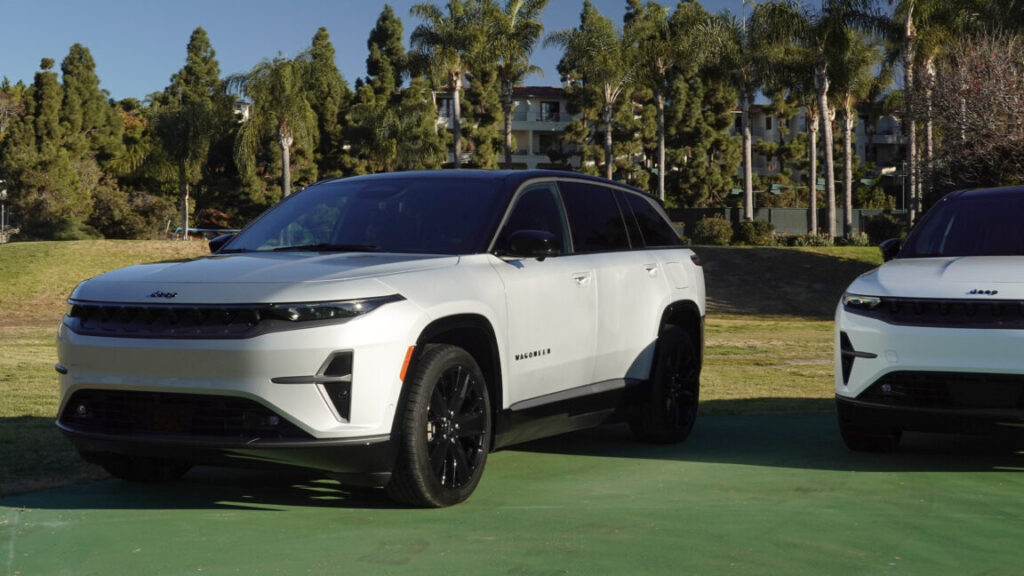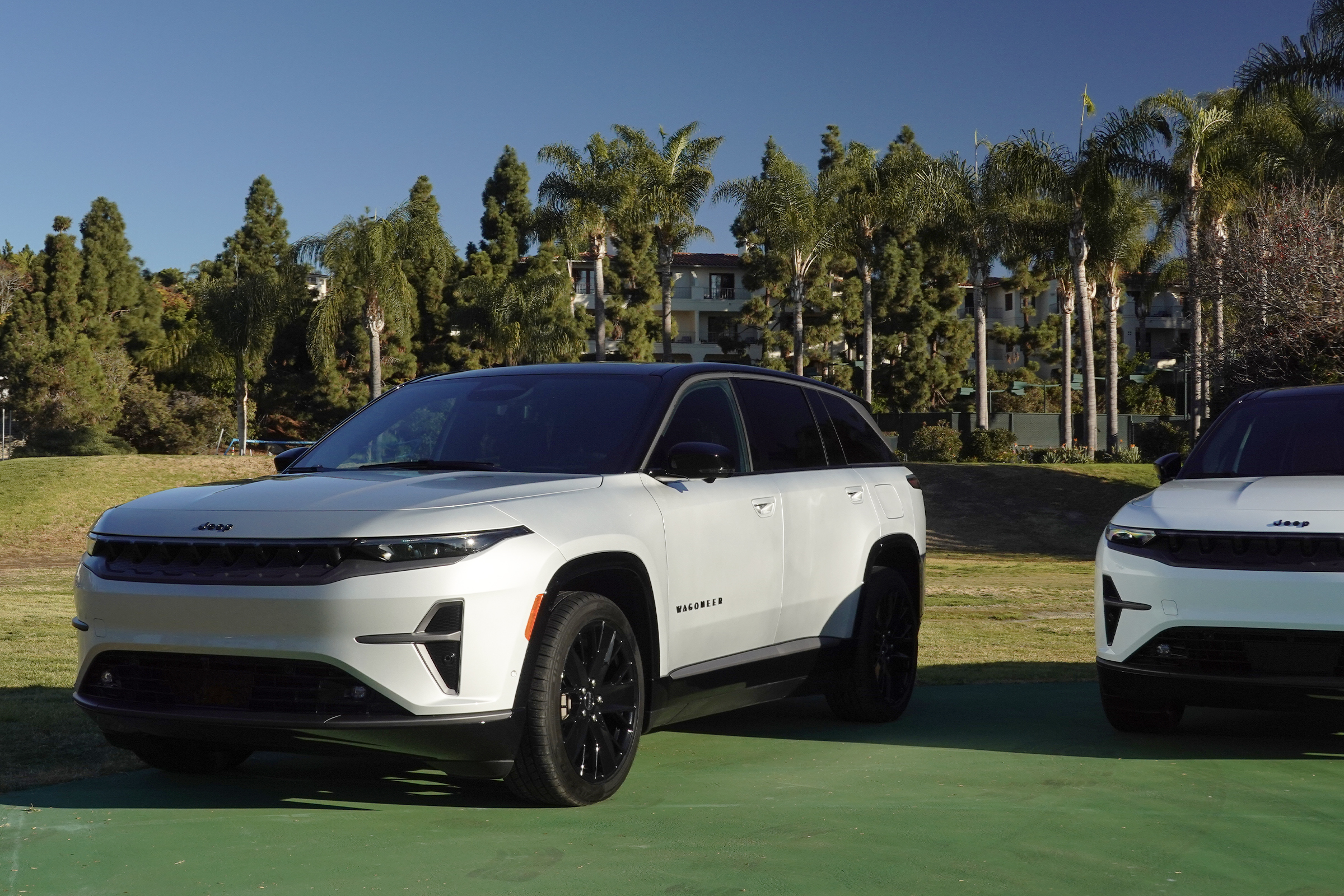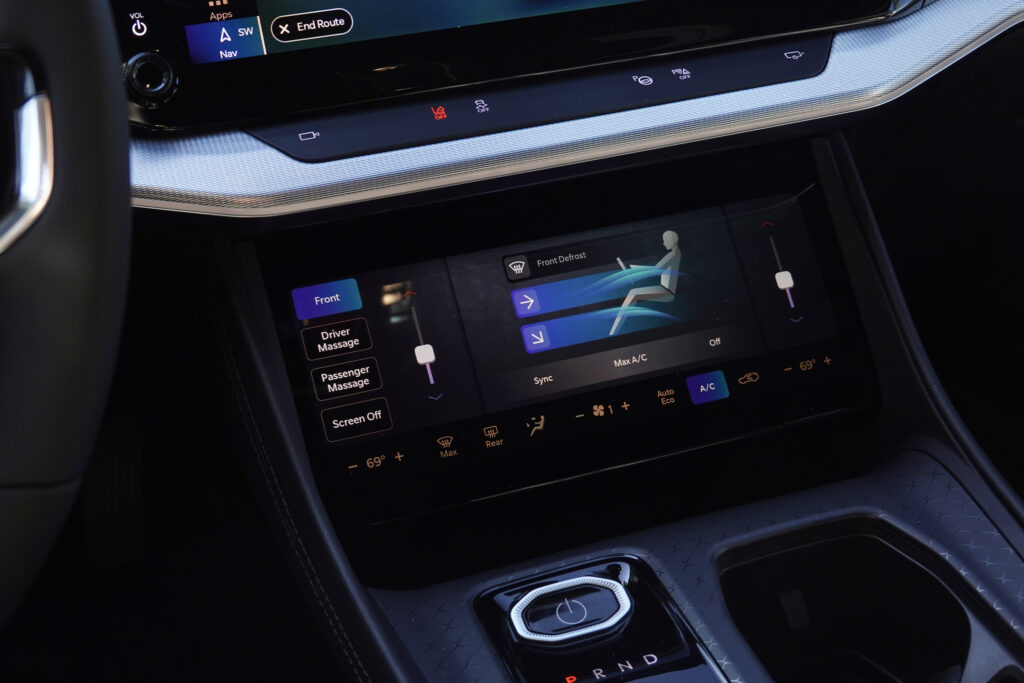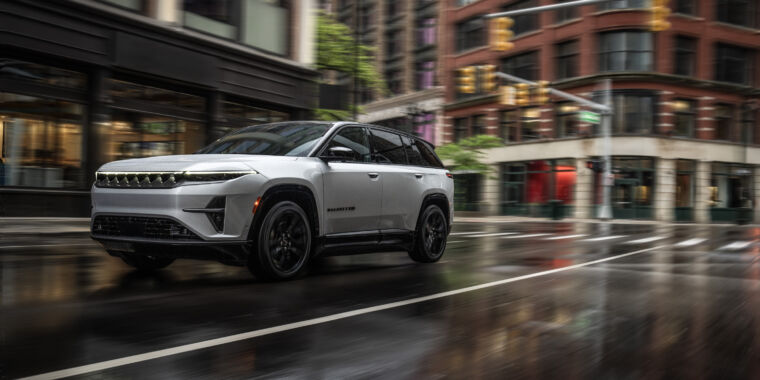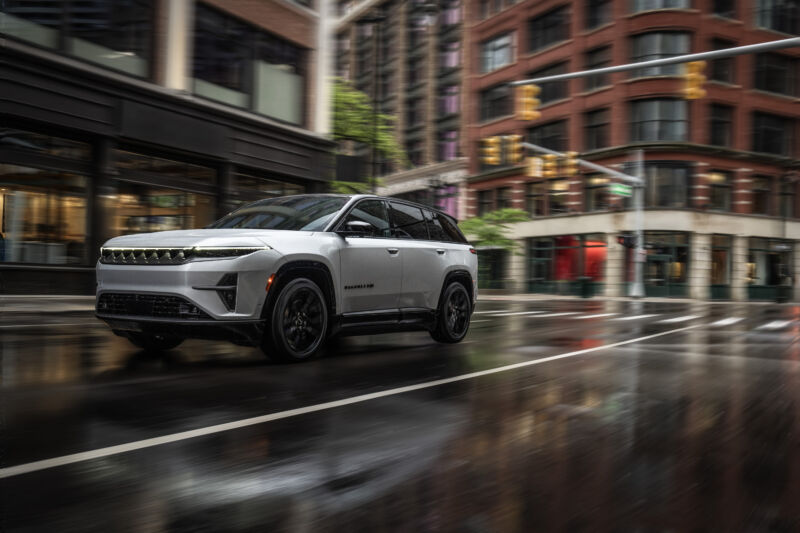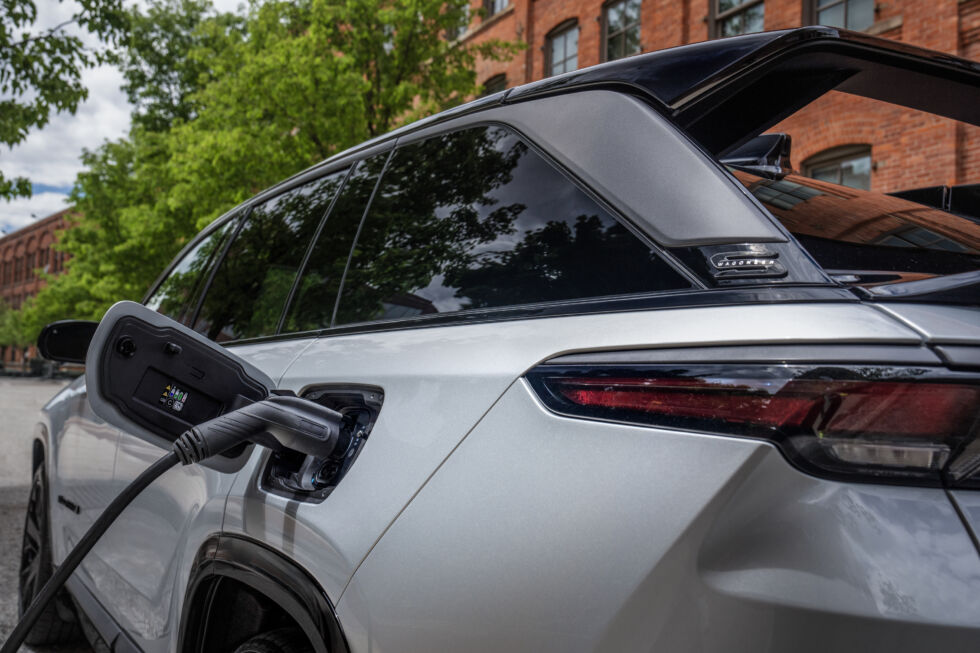Jeep’s first battery EV is not what we expected: the 2024 Wagoneer S
This year marks the return of the Jeep Wagoneer, which formerly served as a more luxurious version of the Cherokee, but now hits the market as Jeep’s first full EV. The challenge? How to merge the modern electric lifestyle with the outdoorsy, rugged ethos that defines Jeep as a brand, alongside the more recent addition of the internal-combustion Grand Wagoneer SUV’s enormous luxury.
First of all, the new Wagoneer S wound up much smaller in person than I expected. The overall profile falls more in line with the shape of mid-size electric crossovers including the Kia EV6, Hyundai Ioniq 5, Chevrolet Equinox, and of course, Tesla’s Model Y. But the interior volume belies that relatively compact exterior, with plenty of space for me at 6’1″ (185 cm) to sit comfortably in both the front and rear seats. Total cargo volumes of 30.6 cubic feet (866 L) with the second row up and 61 cubic feet (1,727 L) with the second row folded flat end up mattering less than the large floor footprint, because the height used to calculate those measurements drops with the low sloping roofline and rear window.
Much of the interior space can be attributed to packaging of the Wagoneer EV’s battery. Rather than going for all-out kilowatt-hours in a dedicated skateboard layout, Jeep instead used the Stellantis group’s STLA Large platform, in this case stuffed with a 100.5-kWh lithium ion pack built on 400 V architecture. That’s enough for an EPA-estimated 303 miles of range (487 km), a solid figure but not a seriously impressive efficiency stat. In comparison, the world-beating Lucid Air Pure RWD manages about 40 percent more range per kilowatt-hour and a Polestar 3 AWD does about 18 percent worse. Claimed DC fast charge times of 23 minutes for a 20-80 percent top up, or 100 miles (160 km) in 10 minutes similarly get the job done without standing out from the pack.
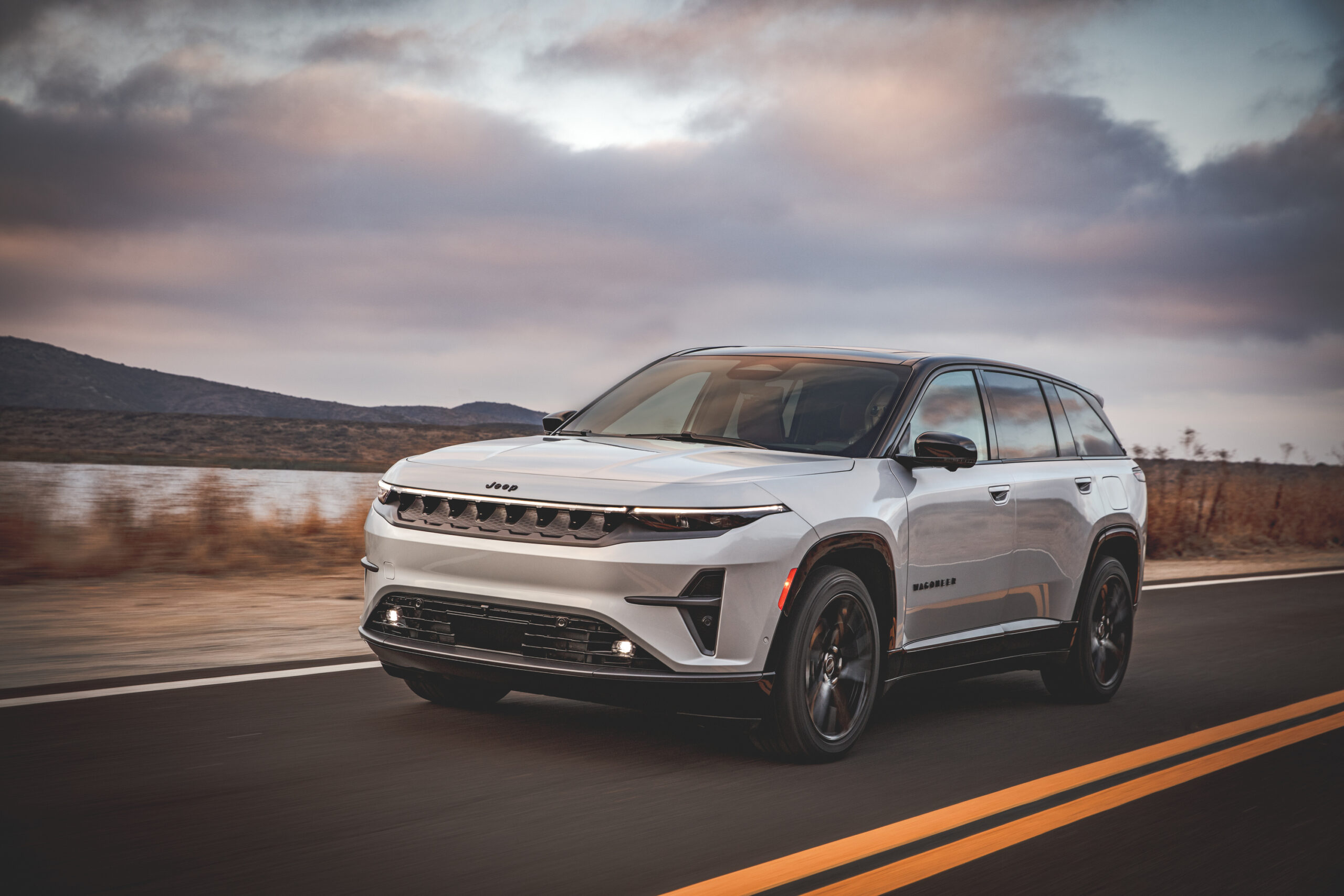
Credit: Jeep
That modular STLA Large chassis can house either a full internal-combustion engine, a hybrid powertrain, or fully electric components. The Wagoneer S uses two matching 335 hp (250 kW) motors, front and rear, for a combined 600 hp (447 kW) and 618 lb-ft of torque (838 Nm). In typical EV fashion, the latter comes on quick and makes this undoubtedly the fastest accelerating Jeep ever, as I learned while battling horrendous headwinds in fire-ravaged Southern California (which served as something of a nonstop reminder of the importance of taking baby steps, a la Jeep’s first EV, toward a more sustainable transportation future).
Pushing deep into the “throttle” pedal, the Wagoneer S will happily chirp all four tires in Sport mode. And the jerk thrusting my torso and skull back into the plush seat suggests that Jeep’s claimed 0-60 mph time of 3.4 seconds might just be accurate, potentially thanks to being able to do a true launch by stepping on the brake and gas pedals simultaneously—possible because Jeep chose to retain more standard mechanical brakes rather than a brake-by-wire system as on the EV6/Ioniq siblings and Model Y.
The suspension tuning definitely trends toward the typical tautness of today’s crossover segment, where aspirational sporty dynamics can sometimes create harsh and uncomfortable ride quality. But I still might have ventured to call the Wagoneer S somewhat softer than most of the competition, until the roughest of roads revealed the 5,667 lb (2,570 kg) curb weight. For an EV, that figure falls roughly in the middle of the pack, but this crossover weighs about as much as a full-size internal-combustion three-row SUV.
Still, even at highway speeds (in gale-force winds) or on those roughest of roads, the Wagoneer S remains shockingly quiet. And not just to enhance the experience of the Wagoneer S Launch Edition’s 1,200 W Macintosh sound system. Instead, Jeep exterior designer Vince Galante walked me through the design process, which kicked off with a targeted 0.30 coefficient of drag despite the need to stick with a squared-off, upright SUV posture typical of Jeeps throughout history.
“On the exterior design portion, the aerodynamic drag is our biggest contributor,” Galante told me. “It kind of comes up off the hood, up the A pillar, and tapers down towards the back, and finishes in a square, yet tapered pillar reminiscent of the original Wagoneer. But through the middle of the car, it’s basically ideal for what the wind wants to do.”
From the front or side perspective, this Wagoneer looks almost as boxy as a 1980s Jeep. But a rear viewing angle reveals the massive rear wing creating that illusion, which sits well off the sloping line of the rear roof and glass.

Credit: Michael Teo Van Runkle
“Anytime we do a floating element, we think ‘Yeah, there’s no way engineering’s gonna let us get away with this,'” Galante laughed. “We work really collaboratively with the engineers, and they were like, ‘Let’s test it. Let’s see what it does.’ And they came back and said, ‘You know, yeah, this has potential. But you guys gotta make it sit off the surface three times more dramatically.'”
Galante estimates the original wing design rose up two inches, while the final production version is more like nine inches off the rear window. He also pointed out a host of other less obvious details, from body panels that step in by fractions of millimeters to differently rounded radii of wheel arch edges, and especially the confluence where the A pillar connects to the body.
“The windshield, the A pillar, the side glass, the mirror, the post that holds the mirror, the fender, everything comes together there,” he said. “I think every vehicle I’ve ever worked on, that was the last thing to finalize in the wind tunnel… I mean, we’re talking tenths of millimeters for some of the iterations that we’re doing in those areas. Especially the front edge of the A pillar, I can recall trying twenty, thirty, forty different radii on there to get that just right.”
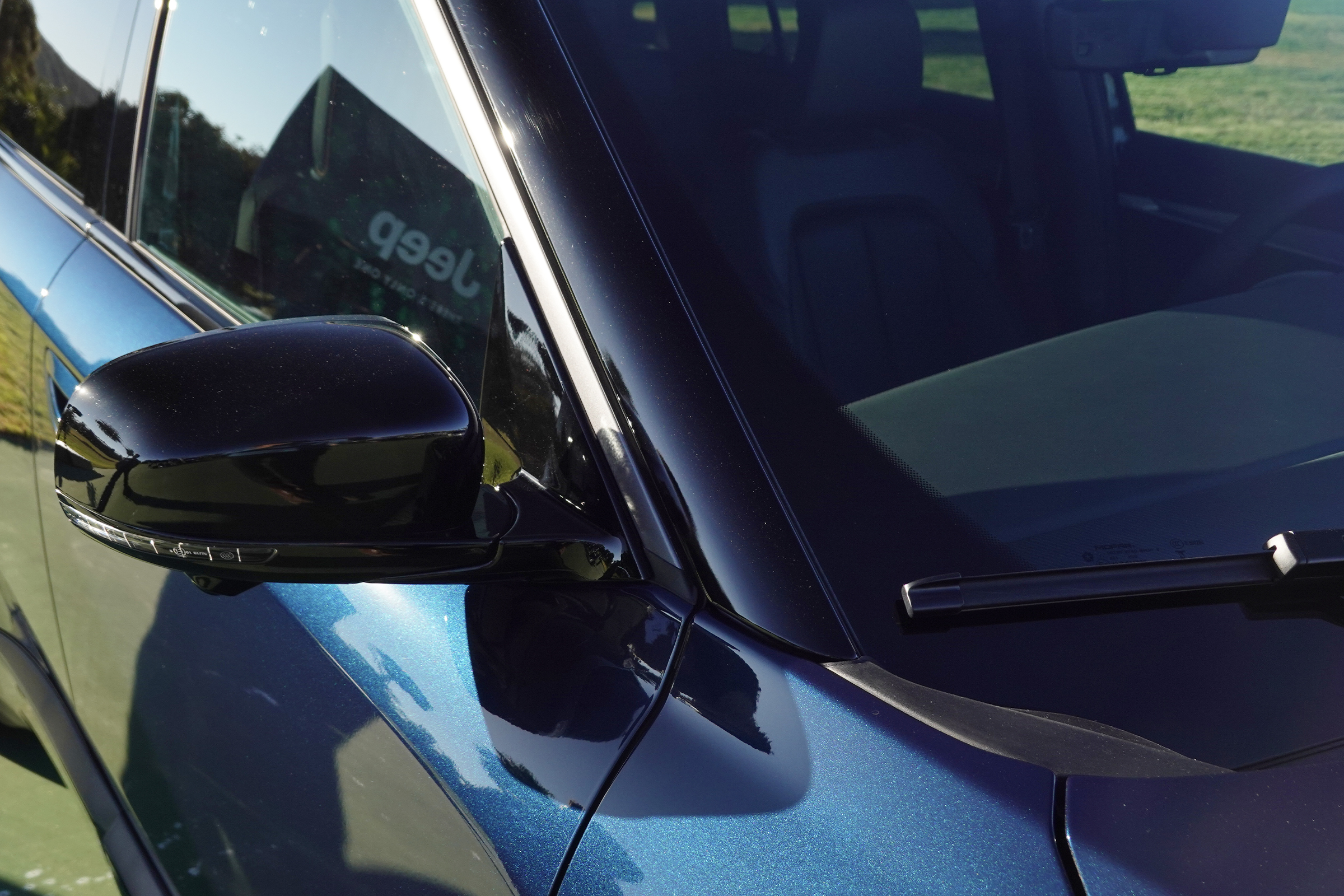
Credit: Michael Teo Van Runkle
All the aero considerations attempt to coax air to stick to surfaces, then break off suddenly and evenly. The rear wing therefore pushes air down toward the rear window, while creating as little turbulence as possible. The final range figure critically—and barely—cracking 300 miles justified so much refinement in Jeep’s new rolling road wind tunnel, thanks to a final Cd of 0.294. Maybe juggling production cost savings of the STLA Large platform dictated such extensive aerodynamic efforts more than a dedicated skateboard battery layout might have, but the resulting quietude that combating those inefficiencies produced does truly border on a luxury experience, even if we’re not quite at Audi (nor Lucid) levels of silence.
On the interior, Jeep also tried to lean into the Wagoneer S’s sustainability, using quality materials with textural designs and as little piano-black plastic as possible. The fabrics, plastics, and aluminum trim come almost entirely from recycled sources—62 percent for suede and 100 percent for fabric and carpeting, in fact—and you’ll see zero chrome anywhere on the car, since chroming is apparently one of the most environmentally deleterious processes in all of automaking.
But the Wagoneer S similarly leans into a tech-heavy user experience, with almost 55 inches of screen visible from the front seats: the gauge cluster, center infotainment, climate controls, passenger dash screen, and digital rearview mirror all contribute to that total. Climate control, especially, seems critical—and an often overlooked element for many EV manufacturers. Rather than a full panoramic glass roof, as on the Lucids and Polestars of the world, this Jeep gets a long sunroof with a retracting insulated cover to keep out heat. The excellent ventilated front and rear seats (and massaging, for the fronts!) also more efficiently cool down passengers.
For my taste, the digitalization of driving went a little too far. I never enjoy a rotating shift knob but this one clicks into gear with a positive heft. I also noticed some pixelation and latency in the gauge cluster’s navigation maps, as if the refresh rate was too slow for the speed I was driving. Not that I started ripping up the road too much in this luxury crossover, or at least, not more often than scientific experimentation demanded (and a similar problem also affected the Dodge Charger EV we drove recently).
Sport mode brought out some of my inner grinning child, but I actually preferred the Wagoneer S in Eco mode. So much power split to the front and rear wheels can create some torque steer, and throttle response that borders on touchy. The electrically assisted steering also prioritizes a heavy on-center zone, then snaps to light inputs with the slightest turn of the wheel, which made holding a steady line slightly distracting.
Instead, Eco dulls down the throttle response and the steering becomes a bit less reactive. The Wagoneer S will then also more regularly disconnect the front wheels for improved efficiency—though at the hubs, rather than the axles, so some reciprocating mass still saps precious electrons.
It would be more efficient to disconnect the rears, but this decision also centers around maintaining some semblance of Jeep-ness. Even if the Wagoneer S aligns most nearly with recent Cherokee and Grand Cherokee models, rather than the off-roady Wrangler and Gladiator or the super-luxe Grand Wagoneer. The forthcoming Trailhawk version promises to double down on the 4×4 capability, with a locking rear differential, better tires, and hopefully better suspension than I experienced on a quick sojourn off the asphalt onto a slightly rutted gravel road east of San Diego.
More importantly, cheaper trims will arrive later in 2025, also, since the Launch Edition’s tall ask of $71,995 almost doubles the starting sticker of a Equinox EV, seriously eclipses either a Model Y, EV6, or Ioniq 5, and also somehow costs more than a Polestar 3 or even a Lucid Air. Jeep so far wants to keep pricing for those lower-spec Wagoneer EVs under wraps, though, even if the heart of the run will undoubtedly help the first electric Jeep more effectively escape from unfortunate comparisons to such stiff competition.
Jeep’s first battery EV is not what we expected: the 2024 Wagoneer S Read More »
